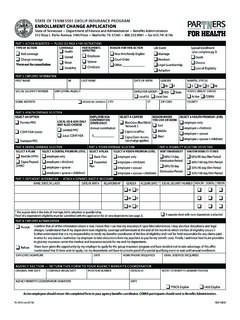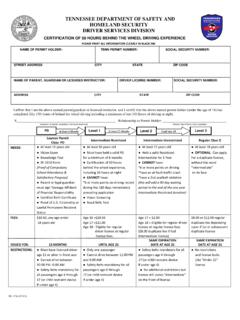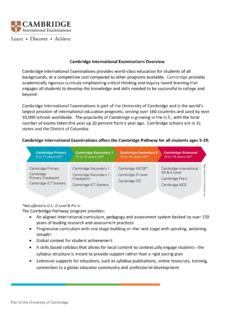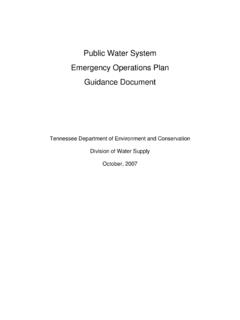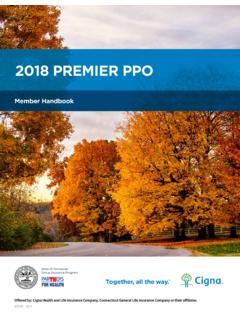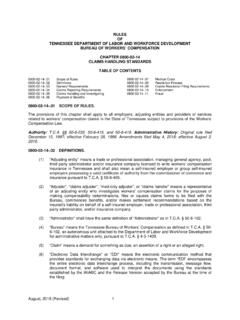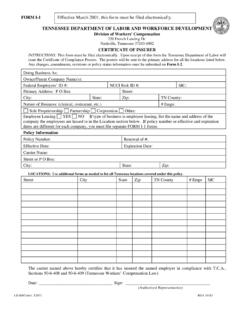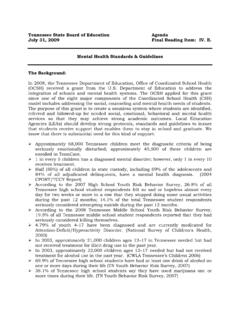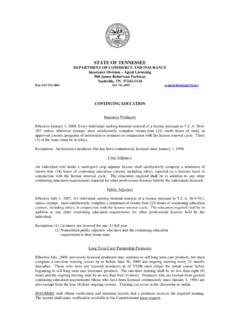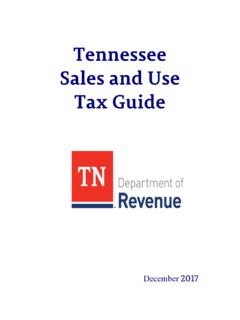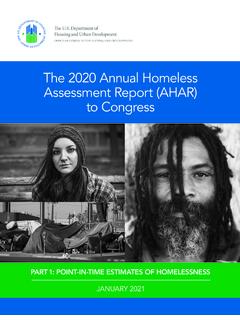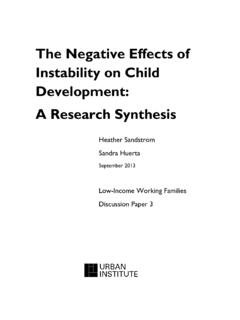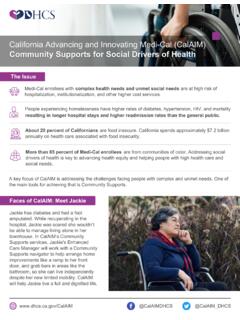Transcription of ARPA: State and Local Fiscal Recovery Fund
1 A RPA: State and Local Fiscal Recovery Fund Treasury Final Rule Key Updates January 12, Treasury Final Rule Key Updates:Final Rule OverviewFinal Rule: Effective Date The final rule takes effect on April 1, 2022. Until that time, the IFRremains in effect. However, recipients can choose to take advantage of the final rule s flexibilities and simplifications NOW. Treasury will not take action to enforce the IFRto the extent that a use of funds is consistent with the terms of the final rule, regardless of when the SLFRF funds were Rule: Overview Delivers broader flexibility and greater simplicity, including the following broad additions: Replacing Lost Public Sector Revenue The final rule offers a standard allowance for revenue loss of $10 million, allowing recipients to select between a standard amount of revenue loss or complete a full revenue loss calculation. Public Health and Economic Impacts In addition to programs and services, the final rule clarifies that recipients can usefunds for capital expenditures that support an eligible COVID-19 public health oreconomic response.
2 In addition, the final rule provides an expanded set of households and communitiesthat are presumed to be impacted and disproportionately impacted by thepandemic, thereby allowing recipients to provide responses to a broad set ofhouseholds and entities without requiring additional Rule: Overview Premium Pay Delivers more streamlined options to provide premium pay, by broadening the share of eligible workers who can receive premium pay without a written justification while maintaining a focus on lower-income and frontline workers performing essential work. Water, Sewer & Broadband Infrastructure Broadens eligible broadband infrastructure investments to address challenges with broadband access, affordability, and reliability, and adds additional eligible water and sewer infrastructure investments, including a broader range of lead remediation and stormwater management Treasury Final Rule Key Updates:Lost RevenueLost RevenueDetermine revenue loss, using one of two available options: Elect standard allowance of up to $10 millionto spend on government services through the life of the program, which greatly simplifies the program for small localities; OR Calculate actual revenue loss according to Treasury formula: Calculate revenue loss either on a calendar or Fiscal year basis.
3 Must adjust actual revenue totals for the effect of tax cuts and tax increases that are adopted after January 6, 2022, to more accurately reflect revenue loss due to the pandemic. Change in revenue loss formula also includes increase in the standard growth rate from to recipients are allowed to use when calculating counterfactual Revenue Government services generally include any service traditionally provided by a government such as: Construction of schools and hospitals Road building and maintenance Health and other services Environmental remediation Provision of police, fire, and other public safety services (including purchase of fire trucks and police vehicles) Water and sewer infrastructure Treasury Final Rule Key Updates:Public HealthPublic Health COVID Mitigation and Prevention Recipients may use these funds to support their COVID-19 public health response. Broad range of services and programming that are needed to contain COVID-19, including vaccination and testing programs and other COVID mitigation tactics May include certain capital expenditures, such as medical facilities generally dedicated to COVID-19 treatment and mitigation More details can be found on page 14 of the Final Rule OverviewPublic Health Behavioral Healthcare Broadrange of prevention, treatment, harm reduction, and Recovery servicesthat may be needed to meet mental health, substance use, and other behavioral health needs May include certain capital expenditures, such as behavioral health facilities and equipment More details can be found on page 15 of the Final Rule OverviewPublic Health Medical Expenses Funds may be used for expenses to households, medical providers, or others that incurred medical costs due to the pandemic, including.
4 Unreimbursed expenses for medical care for COVID-19 testing or treatment Paid family and medical leave for public employees to enable compliance with COVID-19 public health precautions Emergency medical response expenses Treatment of long-term symptoms or effects of COVID-19 More details can be found on Page 15 of the Final Rule OverviewPublic Health Preventing and responding to violence Recognizing that violence and especially gun violence has increased in some communities due to the pandemic, recipients may use funds to respond in these communities through: Referrals to trauma Recovery services for victims of crime Community violence intervention programs Enforcement efforts to reduce gun violence More details can be found on page 15 of the Final Rule Treasury Final Rule Key Updates:Economic ImpactEconomic Impact Assistance to Households Who can you provide assistance to? Assistance to households or populations facing negative economic impacts due to COVID 19 is also an eligible use.
5 Final Rule has more specifically addressed those communities presumed to be impactedincluding: Low- and- moderate income (LMI) households, defined as those at or below 300% of FPG or 65% of AMI Households experiencing unemployment or food or housing insecurity Households that qualify for certain federal programsEconomic Impact Assistance to Households Disproportionately impacted households are those that have experienced a disproportionate impact from the COVID-19 pandemic, including: Low income (LI) households, defined as those at or below 185% of FPG or 40% of AMI Households located in QCTs Households receiving services from Tribal govs Households residing in the territories or receiving services from territorial governments Households that qualify for certain federal programsEconomic Impact Assistance to Households What type of assistance is allowed? Treasury, in the Final Rule, includes the following new uses of fundsto impacted households: Health Insurance coverage expansion and paid sick and family leave Financialservicesfor unbanked and underbanked Affordable housing development and permanent supportive housing Childcare, early learning, and addressing learning loss for K-12 students Improvementsto vacant and abandoned property(More details can be found on page17 of the Final Rule Overview)Economic Impact Assistance to Small Businesses Final Rule includes the following new criteria to assess which small businesses were impacted: Recipients may consider: Increased Costs Decreased revenue Gross receipt Financial insecurity Small Businesses presumed disproportionately impacted: Operating in territories Eligible usesinclude.
6 Rehabilitation of commercial properties, storefront and fa ade improvements Technical assistance, business incubators and grants for start-up or expansions Support for microbusinesses ( , childcare, transportation).(More details can be found on page21 of the Final Rule Overview)Economic Impact Assistance to Nonprofits To Assess which non-profits were impacted, recipients may consider Increased costs ( , uncompensated increases in service need) Non-profits presumed disproportionately impacted if: Operating in territoriesEconomic Impact Aid to Impacted Industries Criteriato determine if an industry other than tourism, travel, and hospitality was impacted by the pandemic, including: Experienced at least an 8 percent employment loss from pre-pandemic levels, or Is experiencing comparable or worse economic impacts as the national travel, tourism, and hospitality sectorsas of the date of the Final Rule and the impacts resulted from the COVID-19 public health emergency State and territory recipients also have flexibility to define the industries with greater geographic precision.
7 For example, a State may identify a particular industry in a certain region of a State as impacted.(More Details can be found on page24 of the Final Rule Overview)Economic Impact:Public Sector Capacity Recipients may use these funds to restore and bolster public sector capacity, which supports governments' ability to deliver critical COVID-19 services. New provisions include: Funding for employees who experienced pay reductions or were furloughed Maintaining current compensation levels to prevent layoffs Worker retention incentives, including reasonable increases in compensation More details can be found on page 27 of the Final Rule Treasury Final Rule Key Updates:Capital ExpendituresCapital Expenditures Subject to the same "related and reasonably proportional" standard as other eligible uses Treasury requires a Written Justification (WJ) of capital expenditures greater than or equal to $1 million and requires them as a part of regular reporting if $10 million or more.
8 WJ requires recipients to explain why a capital expenditure is appropriate and why the proposed capital expenditure is superior to alternatives Depending on project size, recipients may be required to submit WJ with reporting; no pre-approval(More details can be found on Page 30 of the Final Rule Overview)Capital Expenditures Examples of eligible capital expenditures: Testing labs and equipment Emergency operations center and equipment Affordable housing Childcare facilities Schools for disproportionately impacted communities Primary care health clinics and hospitals for disproportionately impacted communities Examples of INELIGIBLE capital expenditures: Construction of new correctional facilities due to an increase in rate of crime Construction of new congregate facilities to decrease spread of COVID in facility Construction of convention centers, stadiums, or other large capital projects for general economic development or aid to impacted Treasury Final Rule Key Updates.
9 Premium PayPremium Pay Streamlined options to provide premium pay, by broadening the share of essential workers who can receive premium pay without a written justification while maintaining a focus on lower-income and frontline essential workers Examples of eligible workers: Staff at nursing homes, hospitals, and home-care settings; Public health, safety, and emergency response; State , Local , and Tribal government workforce; Workers at food production facilities, grocery stores, restaurants, and food delivery services; Janitors and sanitation workers; Truck drivers, transit staff, and warehouse workers; Public health and safety staff; Childcare workers, educators, school staff; Social service and human services staff; and Additional sectors designated by Pay Eligible workers in critical infrastructure In-person interactions or physical handling of items handled by others Serves workers who: Earn at or below 150% of their State /county s average annual wage, or Are not exempt from Fair Labor Standards Act overtime rules Or recipient provides written justification of how position meets the Treasury Final Rule Key Updates:Water/Sewer InfrastructureWater & Sewer Infrastructure-Eligible UsesThe Final Rule gives a broad suite of additional lead remediation activities, including: lead testing; lead service line replacement (including replacement of faucets, fixtures, and internal plumbing in schools and childcare facilities).
10 Lead remediation of residential & Sewer Infrastructure-Eligible UsesFinal Rule expands the list of eligible water and sewer infrastructure projects to include a broader set of project types, examples consist of: Certain dam and reservoir rehabilitation projects Private/residential well projects Additional stormwater infrastructure including culvert repair, resizing, and removing Water & Sewer Infrastructure Requirements of FR Treasury will require that recipients engage in a cost-effectiveness analysis when engaging in projects for the creation of: New drinking water systems Dam and reservoir rehabilitation projects Projects for the extension of drinking water service to meet population growth needs Other types of eligible water and sewer projects will not be subject to the cost-effectiveness test, including lead line replacement and lead Treasury Final Rule Key Updates:Broadband InfrastructureBroadband Infrastructure Recipients are encouraged to prioritize projects that are designed to serve locations without access to reliable broadband service but are broadly able to invest in projects designed to provide service to locations with an identified need for additional broadband investment Recipients have broad flexibility to define need in their community Lack of access to a reliable high-speed broadband connection Lackof affordable broadband Lackof reliable service Must meet upload and download speed and requirements outlined in the IFR Recipients may also invest in cybersecurity for broadbandinfrastructure regardless of service delivery standardsBroadband InfrastructureAdditionalrequirement under Final Rule: Providersmust meet one of the following requirements: Participate in the FCC s Affordable Connectivity Program (ACP) or.
